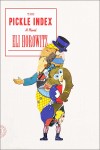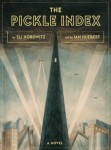The Future of The Book:
Using Pickles
“An app-based novel that aspires to be the most bonkers book ever written.”
That is how BuzzFeed begins a very long profile about the newest project by Eli Horowitz, one of the driving forces behind the indie publishing house McSweeney’s.
Horowitz wants to change how books and reading are understood. His newest effort in that undertaking is The Pickle Index.
Unlike most books that might be described with a plot summary what really matters here is what The Pickle Index is.
As reviewer Carmen Machado describes it for NPR’s Arts & Life review, it is three books and an app.
One is a paperback illustrated with small black and white images: The Pickle Index (Macmillan/FSG Originals; OverDrive Sample).
There is also a hardcover two-book slipcase set edition with illustrations by Ian Huebert, that a la Brian Selznick, have strong story-telling power: The Pickle Index (Sudden Oak Books).
As Machado puts it,
“the illustrations in each [of the hardback volumes] encourage the reader to read the books back and forth, or at the very least turn and twirl the illustrations to see how they connect with, compliment, or contradict each other.”
If that were not enough, the hardcover books are not, as Machado describes, “simply the paperback with color” but are structured differently than the paperback.
Then there is the app, of which Machado says,
“is [a] different thing entirely, while still being more of the same … Once the reader has read the necessarily elements, they can progress through the story in real time, or with the narrative accelerated. Additionally, the app has one-off jokes and minor side plots — including two soldiers trapped in a submarine together, squabbling in the Q&A section. You, the reader, are also integrated into this frustrating world, and have to (among other things) manipulate the Index’s deliberately clunky interface.”
Lost? Horowitz describes it this way to Anne Helen Petersen of BuzzFeed:
“There are all these different ways that you can read that are valid, so I wanted to fully imagine all of those formats. So: the book-iest book I could do, and the app-iest app. Even the paperback, and the Kindle version. They’ll have their own sort of thing, with different reaches and different audiences.”
It might sound overly elaborate and precious, but Horowitz knows his stuff. He has worked with big-named authors including Dave Eggers, Miranda July, Michael Chabon, and Joyce Carol Oates and, says Petersen, “every book he’s written has been optioned for film or television: The New World, published in May, was optioned by Olivia Wilde; The Silent History, a digital app turned paperback from 2012, is slated to become AMC’s new prestige drama.”
There are plenty of people thinking about the future of the book. Horowitz is one of the most creative, telling BuzzFeed, “That’s why I made The Pickle Index in so many forms … To say there’s not a future; there are futures.”
Still wondering what the book is about? Petersen describes it as featuring “a delightfully unskilled circus troupe against the backdrop of a fascist dystopia, united by a forced devotion to fermented items.”


